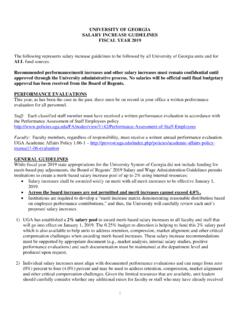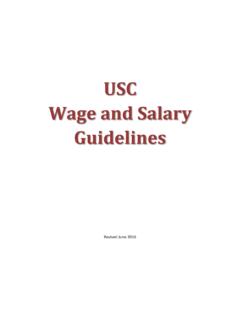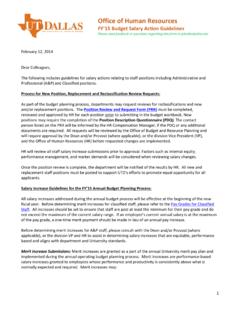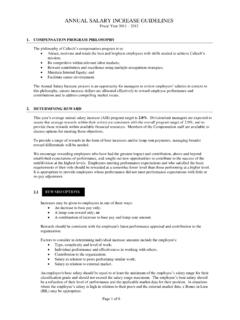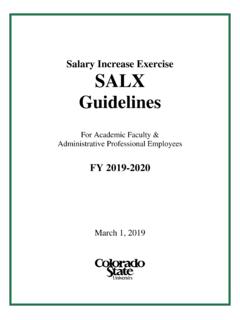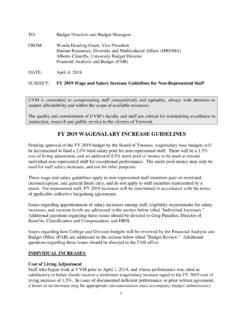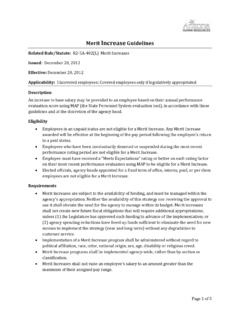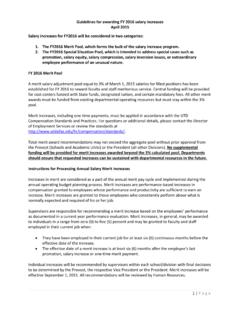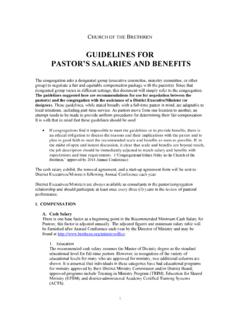Transcription of Pay Policies & Practices - Johns Hopkins University
1 Pay Policies and Practices 1 Pay Policies and Practices New Hire Pay To ensure internal equity, starting salaries are determined based on the applicant s prior experience and/or education directly related to the position. A department may pay starting salaries up to the market reference point or salary range midpoint of a job, or up to the average salary of similar University positions, provided internal equity is observed. With appropriate justification and documented approval by the divisional Human Resources Office or human resources manager and by the appropriate dean or vice president, a hiring official may offer higher starting salaries. Click here for additional details. salary and Career Growth Opportunities The compensation program is designed to reward staff members for developing skills and competencies in their current jobs.
2 It also supports career development by giving a staff member the opportunity to move into a different job within a career path. Many who join the University enjoy long and successful careers. The staff compensation program helps to make this possible by providing opportunities for: salary growth rewarding staff monetarily for significant contributions and increased skills/competencies while working in their current job based on person changes Career growth recognizing and promoting staff for meaningful or significant job changes with ever increasing job responsibilities based on job changes Staff members can build a career that is both financially and professionally rewarding without ever changing jobs or by advancing to different jobs on a career path. The new pay program recognizes that growing in one s current job can be just as important as growing into another job.
3 So, both person-based changes ( , growth in individual skills and competencies within the current job) and job-based changes ( , movement to a different job at a different salary range) can be rewarded under the new program. All salary and career growth opportunities are dependent on departmental need and budgetary availability. The following are examples of salary and career growth opportunities: Pay Policies and Practices 2 Developmental increase A developmental increase may be granted to a staff member who has acquired increased skills and competencies in their current job. This recognizes the staff member s increased value to the University and in the marketplace without reclassifying the staff member to another job. Developmental increases may happen at any time of the year and do not affect a staff member s annual merit increase or review date.
4 To be eligible, a developmental growth plan is developed and approved by the department in partnership with Human Resources. The plan includes milestones for development of recognized skills and a competency required by a job and establishes a working timeframe for meeting those milestones. Example 1: Developmental increase Chris, Administrative Coordinator Administrative/Technical Operations, Level 2 Chris is an Administrative Coordinator, a job that is assigned an operations role and a level 2. The department wants to expand the budget support he provides to faculty. Chris s responsibilities currently include tracking and projections for general funds budgets; his new additional responsibilities will require him to learn about sponsored funds. Chris s supervisor works with Human Resources to create a developmental growth plan for the technical skills and knowledge that Chris will need to perform the new job duties.
5 Once these milestones are reached, Chris will receive a developmental increase . His role, level, and salary range will not change; his salary will increase to reward his enhanced skills which make him more valuable to the University . Example 2: Developmental increase Jane Smith, Budget Assistant Administrative/Technical Operations, Level 2 Jane Smith is a budget assistant who joined the University in an administrative/technical operations role, level 2. Before Jane started her position, her manager worked with human resources to create a developmental growth plan to recognize and reward her as she increased skills and competencies. Jane had limited experience with grants and contracts, although her job requires helping monitor grant and contract expenditures. Since Jane still needed to fully develop all the required skills to fully perform her job, her starting salary was at the lower end of the salary range.
6 A developmental growth plan was developed to document the specific additional skills and competencies Jane needed to develop to become fully competent in her job. Jane was a quick learner. In only five months, she learned the requirements of the grants and contracts and demonstrated her ability to do this part of her job well. As a result, she was rewarded with a developmental salary increase . Jane s anniversary date didn t change and at the end of the year she also received an annual increase . Pay Policies and Practices 3 Jane s role, level, and salary range remained the same. As Jane demonstrated increased skills and competencies required for her job, her manager was able to reward her financially. Click here for additional details. Promotional Increases Staff members who are focused on career growth should think about the two types of promotions available in the staff compensation program: a market-based promotion and a contribution level promotion.
7 The following are examples of each: Example 1: Market-Based Promotion Bob, Research Program Coordinator Academic/Clinical/Research Operations, Level 3 Market-based promotion A market-based promotion means that a staff member has made a meaningful job change to a new job with increased responsibilities and higher pay in the market. While the salary range may be higher, the role of the job may not change, and the contribution level of the job does not change. Bob, a Research Program Coordinator, is currently classified in an operations role, level 3. Once Bob takes on supervision of other field staff, he receives a market-based promotion to Research Program Supervisor. This means Bob will be reassigned to a higher salary range in the Academic/Clinical/Research operations role, but he will remain a level 3. Example 2: Market-Based Promotion Jane Smith, Budget Specialist Administrative/Technical Operations, Level 2 After one year of employment as a budget assistant, Jane took on additional responsibilities which resulted in her moving into a budget specialist job.
8 The budget specialist job has a higher salary range because it has more responsibilities and is paid more in the market. However, both the budget assistant and budget specialist jobs are classified in an administrative/technical operations role at the same level a level 2. Jane received a market-based promotional increase because her new job was in a higher market-based salary range with more potential for both salary and professional growth. For her new position, Jane s manager worked with HR once again to create a new developmental growth plan with milestones for increasing the skills and competencies required for the job. When Jane reached these, she was eligible to receive developmental salary increases. Contribution Level Promotion Pay Policies and Practices 4 A contribution level promotion reflects a significant job change.
9 A staff member who receives a contribution level promotion moves to a job that has a higher contribution level and a higher salary range. That staff member s role may change as well. Example 1: Contribution Level Promotion Jane Smith, Budget Analyst Administrative/Technical Professional, Level 3 Jane has gained skills and competencies, her performance is outstanding, and she is recognized as an expert in her department. She has a few years of experience as a budget specialist and is ready to assume a job with greater responsibilities. The next step on the career ladder for Jane would be to become a budget analyst. This job requires developing budgets, performing budget projections, resolving short-falls, and interpreting Policies and procedures for the department. A budget analyst is classified in a professional role at a level 3 with a higher salary range.
10 This will be a contribution level promotion for Jane; her role, level, and salary range will change and she will receive a salary increase . Click here for additional details. Pay Policies and Practices 5 In-Range salary increase An in-range salary increase is given to recognize an employee for meaningful increased duties and responsibilities in the current job classification (without a change in classification level and/or salary range). Click here for additional details. Click here for In-Range salary increase form. Annual Performance and salary Review Staff members are eligible for a merit increase annually. Merit increases are based on the staff member s performance during the prior year and the salary increase budget available within the department. Performance is evaluated according to the current job description and accomplishments of goals, objectives, and/or special projects and assignments.
